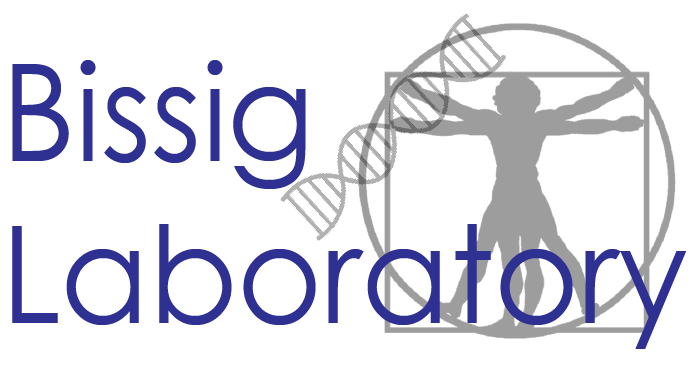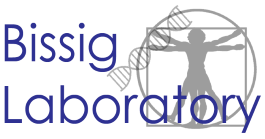Featured Publications
Chen T, Barzi M, Furey N, Kim HR, Pankowicz FP, Legras X, Elsea SH, Hurley AE, Yang D, Wheeler DA, Borowiak M, Bissig-Choisat B, Sumazin P, Bissig KD CRISPR/Cas9 gene therapy increases the risk of tumorigenesis in the mouse model of hereditary tyrosinemia type I JHEP Rep. 2025 Jan. 11:101327. PMID: 40212789
The therapeutic potential of CRISPR gene editing has been demonstrated in various animal models; however, little is known about its long-term consequences. This study seeks to bridge this gap by investigating the lasting consequences of CRISPR gene therapy in an animal model of hereditary tyrosinemia type I (HT-I). We compared the standard of care-nitisinone, a small molecule inhibitor of hydroxyphenylpyruvate dioxygenase (HPD)-with the deletion of the Hpd gene by CRISPR gene therapy. Both treatments block flux through tyrosine catabolism and thereby prevent the accumulation of toxic catabolites in HT-I.
Barzi M, Chen T, Gonzalez TJ, Pankowicz FP, Oh SH, Streff HL, Rosales A, Ma Y, Collias S, Woodfield SE, Diehl AM, Vasudevan SA, Galvan TN, Goss J, Gersbach CA, Bissig-Choisat B, Asokan A, Bissig KD. A humanized mouse model for adeno-associated viral gene therapy. Nat. Commun. 2024 Mar. 15:1955. PMID: 38438373
Clinical translation of AAV-mediated gene therapy requires preclinical development across different experimental models, often confounded by variable transduction efficiency. Here, we describe a human liver chimeric transgene-free Il2rg−/−/Rag2−/−/Fah−/−/Aavr−/− (TIRFA) mouse model overcoming this translational roadblock, by combining liver humanization with AAV receptor (AAVR) ablation, rendering murine cells impermissive to AAV transduction. Using human liver chimeric TIRFA mice, we demonstrate increased transduction of clinically used AAV serotypes in primary human hepatocytes compared to humanized mice with wild-type AAVR. Further, we demonstrate AAV transduction in human teratoma-derived primary cells and liver cancer tissue, displaying the versatility of the humanized TIRFA mouse. From a mechanistic perspective, our results support the notion that AAVR functions as both an entry receptor and an intracellular receptor essential for transduction. The TIRFA mouse should allow prediction of AAV gene transfer efficiency and the study of AAV vector biology in a preclinical human setting.
Barzi M, Johnson CG, Chen T, Rodriguiz RM, Hemmingsen M, Gonzalez TJ, Rosales A, Beasley J, Peck CK, Ma Y, Stiles AR, Wood TC, Maeso-Diaz R, Diehl AM, Young SP, Everitt JI, Wetsel WC, Lagor WR, Bissig-Choisat B, Asokan A, El-Gharbawy A, Bissig KD. Rescue of glutaric aciduria type I in mice by liver-directed therapies. Sci. Transl. Med. 2023 April. 15:692. PMID: 37075130
Glutaric aciduria type I (GA-1) is an inborn error of metabolism with a severe neurological phenotype caused by the deficiency of glutaryl–coenzyme A dehydrogenase (GCDH), the last enzyme of lysine catabolism. Current literature suggests that toxic catabolites in the brain are produced locally and do not cross the blood-brain barrier. In a series of experiments using knockout mice of the lysine catabolic pathway and liver cell transplantation, we uncovered that toxic GA-1 catabolites in the brain originated from the liver. Moreover, the characteristic brain and lethal phenotype of the GA-1 mouse model was rescued by two different liver-directed gene therapy approaches: Using an adeno-associated virus, we replaced the defective Gcdh gene or we prevented flux through the lysine degradation pathway by CRISPR deletion of the aminoadipate-semialdehyde synthase (Aass) gene. Our findings question the current pathophysiological understanding of GA-1 and reveal a targeted therapy for this devastating disorder.
Bissig-Choisat B, Wang L, Legras X, Pradip KS, Chen L, Bell P, Pankowicz FP, Hill MC, Barzi M, Kettlun Leyton C, Eastwood LC, Kruse RL, Himes RW, Goss JA, Wilson JM, Chan LL, Lagor WR and Bissig KD Development and rescue of human familial hypercholesterolemia in a xenograft mouse model. Nat Commun. 2015 June. 6:7339. PMID: 26081744
Dysregulation of lipid metabolism is associated with cardiovascular disease, metabolic syndrome, diabetes, and other conditions that have become significant health problems. Unfortunately, species differences in lipid metabolism have made it difficult to model lipid pathways in rodents or draw reliable conclusions from animal studies. Here we transplanted liver cells from human patients with familial hypercholesterolemia, a severe form of lipid dysregulation, and demonstrate not only that this mouse develops hypercholesterolemia that physiologically recapitulates the human disease, but also that gene therapy corrected the underlying defect and restored the human hepatocytes in the mouse to normal function. This was the first xenograft model for a metabolic liver disease that allowed the testing of a macromolecular therapy, which traditionally could be validated only in human clinical trials.
Pankowicz FP, Barzi M, Legras X, Hubert L, Mi T, Tomolonis JA, Ravishankar M, Sun Q, Yang D, Borowiak M, Sumazin P, Elsea SH, Bissig-Choisat B, Bissig KD Reprogramming metabolic pathways in vivo with CRISPR/Cas9 genome editing to treat hereditary tyrosinaemia. Nat Commun. 2016 August 7:12642. PMID: 27572891
Many metabolic liver disorders are refractory to drug therapy and require liver transplantation. Here we demonstrated a new strategy, which we call metabolic pathway reprogramming, to treat hereditary tyrosinemia type I in mice; rather than edit the disease-causing gene, we delete a gene in a disease-associated pathway to render the phenotype benign. Using CRISPR/Cas9 in vivo, we converted hepatocytes from having the neonatally fatal tyrosinemia type I to having the benign tyrosinemia type III by deleting Hpd (hydroxyphenylpyruvate dioxigenase). Hpd excision successfully reroutes tyrosine catabolism, leaving treated mice healthy and asymptomatic. Metabolic pathway reprogramming sidesteps potential difficulties associated with editing a critical disease-causing gene and can be explored as an option for treating other diseases
Bissig-Choisat B, Kettlun-Leyton C, Legras XL, Zorman B, Barzi M, Chen LL, Amin MD, Huang YH, Pautler RG, Hampton OA, Prakash MM, Muzny D, Doddapaneni H, Hu J, Shi Y, Gaber WM, Hicks MJ, Thompson PA, Lu Y, Mills GB, Finegold M, Goss JA, Parsons DW, Vasudevan SA, Sumazin P, Lopez-Terrada D, Bissig KD Metastatic patient-derived xenograft model and isogenic cell lines for pediatric liver cancer research. J Hepatol. 2016 April 65(2):325-33. PMID: 27117591
Pediatric liver cancer is a rare but serious disease that is poorly understood; no experimental animal model has been able to replicate the behavior and molecular mechanisms driving these tumors. In this paper, we developed a new orthotopic technique that enabled us to graft a series of patient-derived tumor cells into mice, from all major subtypes of pediatric liver cancer: hepatoblastoma, hepatocellular cancer, and hepatocellular malignant neoplasm. We also developed stem cell culturing techniques to derive new pediatric cancer cell lines from the xenografted mice. This study demonstrated that the patient-derived tumor xenografts recapitulate the histological, genetic, biological, and behavioral characteristics of the primary tumors. We tested a therapy for an aggressive hepatocellular malignant neoplasm with the MEK1 inhibitor trametinib and the IPI3 kinase inhibitor NVP-BKM120, which strongly inhibited tumor growth. This model is thus a valuable tool for studying tumor biology and patient-specific therapeutic responses.
Barzi M, Pankowicz FP, Zorman B, Liu X, Legras X, Yang D, Borowiak M, Bissig-Choisat B, Sumazin P, Li F, Bissig KD. A novel humanized mouse lacking murine P450 oxidoreductase for studying human drug metabolism." Nat Commun. 2017 June 28;39:s41467-017. PMID: 28659616
Only one out of 10 drugs in development passes clinical trials. Many fail because experimental animal models do not replicate human drug metabolism. Human liver chimeric mice are a step forward in this regard, as the human hepatocytes in chimeric livers generate human metabolites, but the remaining murine hepatocytes contain an expanded set of P450 cytochromes that form the major class of drug-metabolizing enzymes. We therefore generated a conditional knock-out of the NADPH-P450 oxidoreductase (Por) gene in our humanized (PIRF) mice. Here we show that homozygous PIRF mouse livers are readily repopulated with human hepatocytes, and when the murine Por gene is deleted, they predominantly use human cytochrome metabolism. When given the anticancer drug gefitinib or the retroviral drug atazanavir, the Por-deleted humanized PIRF mice develop higher levels of the major human metabolites than current models. Humanized, murine Por-deficient PIRF mice can thus predict human drug metabolism and should be useful for preclinical drug development.
Pankowicz FP, Barzi M, Kim KH, Legras X, Martins CS, Wooton-Kee CR, Lagor WR, Marini JC, Elsea SH, Bissig-Choisat B, Moore DD, Bissig KD. Rapid Disruption of Genes Specifically in Livers of Mice Using Multiplex CRISPR/Cas9 Editing Gastroenterology. 2018 June 155(6):1967-1970. Pubmed PMID: 30170115
Despite tremendous advances in gene editing, it remains time-consuming and technically challenging to knock out genes in specific tissues. Here we developed an approach that enables any lab to use a CRISPR/Cas9 system to disrupt genes in livers of adult mice within just a few months. We used this somatic liver knockout (SLiK) approach to create a liver-specific knockout of argininosuccinate lyase; the mice develop hyperammonemia, just as do human patients with the same defect. We also used the SLiK system to knock out expression of five different enzymes involved in drug metabolism within the same mouse liver —something that would be exceedingly difficult to do with traditional mouse transgenic tools.
Journal articles
Valanejad L, Cast A1, Wright M, Bissig KD, Karns R, Weirauch MT, Timchenko N. PARP1 activation increases expression of modified tumor suppressors and pathways underlying development of aggressive hepatoblastoma. Commun Biol. 2018 June 1:67. Pubmed PMID: 30271949
Kho J, Tian X, Wong WT, Bertin T, Jiang MM, Chen S, Jin Z, Shchelochkov OA, Burrage LC, Reddy AK, Jiang H, Abo-Zahrah R, Ma S, Zhang P, Bissig KD, Kim JJ, Devaraj S, Rodney GG, Erez A, Bryan NS, Nagamani SCS, Lee BH. Argininosuccinate Lyase Deficiency Causes an Endothelial-Dependent Form of Hypertension AJHG. 2018 August 103(2):276-287. Pubmed PMID: 30075114
Kruse RL, Shum T, Tashiro H, Barzi M4, Yi Z, Whitten-Bauer C, Legras X, Bissig-Choisat B, Garaigorta U, Gottschalk S, Bissig KD. HBsAg-redirected T cells exhibit antiviral activity in HBV-infected human liver chimeric mice. Cytotherapy. 2018 May 20(5):697-705. Pubmed PMID: 29631939
Woodfield SE, Shi Y, Patel RH, Jin J, Major A, Sarabia SF, Starosolski Z, Zorman B, Gupta SS, Chen Z, Ibarra AM, Bissig KD, Ghaghada KB, Sumazin P, López-Terrada D, Vasudevan SA. A Novel Cell Line Based Orthotopic Xenograft Mouse Model That Recapitulates Human Hepatoblastoma. Sci Rep. 2017 December 7(1):1775. Pubmed PMID: 29259231
Kruse RL, Shum T, Legras X, Barzi M, Pankowicz FP, Gottschalk S, Bissig KD. In Situ Liver Expression of HBsAg/CD3-Bispecific Antibodies for HBV Immunotherapy. Mol Ther Methods Clin Dev. 2017 August 31;7:32-41. Pubmed PMID: 29018834
Velasquez-Mao AJ, Tsao CJM, Monroe MN, Legras X, Bissig-Choisat B, Bissig KD, Ruano R, Jacot JG. "Differentiation of spontaneously contracting cardiomyocytes from non-virally reprogrammed human amniotic fluid stem cells." PLoS One. 2017 May 17;12(5):e0177824. Pubmed PMID: 28545044
Pankowicz FP, Jarrett KE, Lagor WR, Bissig KD. "CRISPR/Cas9: at the cutting edge of hepatology." Gut. 2017 July;66(7):1329-1340. Pubmed PMID: 28487442
Reviews, commentaries, and invited chapters
Akkina R, Barber DL, Bility MT, Bissig KD, Burwitz BJ, Eichelberg K, Endsley JJ, Garcia JV, Hafner R, Karakousis PC, Korba BE, Koshy R, Lambros C, Menne S, Nuermberger EL, Ploss A, Podell BK, Poluektova LY, Sanders-Beer BE, Subbian S, Wahl A. Small Animal Models for Human Immunodeficiency Virus (HIV), Hepatitis B, and Tuberculosis: Proceedings of an NIAID Workshop. Pubmed PMID: 10.2174/1570162X18666191223114019
"Comprehensive and Integrative Genomic Characterization of Hepatocellular Carcinoma" Cell 2017 Jun 15;169(7):1327-1341. Pubmed PMID: 28622513


